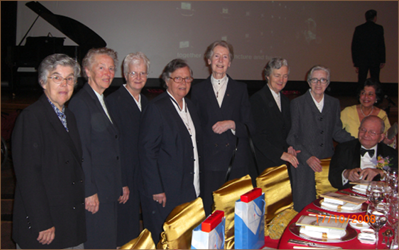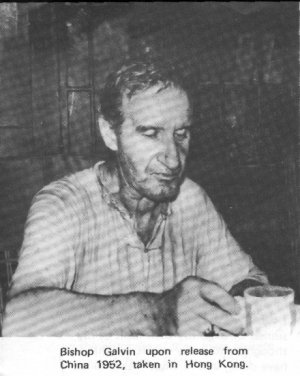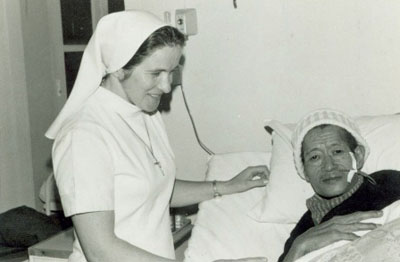Mission comes full circle

Columban Sisters with longtime supporter, Rusy Schroff and his wife,
from left, Sr Nora Mary O’Driscoll, Sr Valerie Hetherton, Sr Nuala Raleigh,
Sr Fintan Ryan, Sr Victoire Ryan, Sr Rita Deegan and Sr Mary Greaney.
Photo: The Hong Kong Tuberculosis Chest and Heart Diseases Association
This was one of a number of articles in the 22 November 2015 issue of Sunday Examiner, the English-language weekly of the Diocese of Hong Kong on the occasion of the Missionary Sisters of St Columban leaving Hong Kong in December 2015 after a presence of 68 years. You will find all the articles on the website of Sunday Examine here.
Seven Columban Sisters, all of whom had worked at the Ruttonjee Sanatorium, as the current general hospital in Wan Chai used to be known, traveled from Ireland to join the 60th anniversary celebration of the Hong Kong Tuberculosis Chest and Heart Diseases Association (formerly the Anti-Tuberculosis Association) during October 2008.
Sr Isobel Loughrey saying goodbye to Hong Kong
Sister Mary Greaney said that when the Columbans began at Ruttonjee in 1948 there was a clear mission to those suffering from tuberculosis (TB). ‘They were the poor and neglected of Hong Kong at the time,’ she explained. ‘However, now the association has broadened its vision into other aspects of public health care, but it has not lost its focus on TB, which unfortunately is making a comeback in the world today.’
The World Health Organisation put TB, which was thought to have been eradicated by the 1980s, back on the critical list in 1993, anticipating around 90 million new cases to be reported in the last decade of the last century. This prompted a former medical officer at the sanatorium, Michael Iseman, to lament, ‘We knew how to cure TB, but we dropped the ball by not ensuring proper treatment.’ Iseman spoke of the breakthrough in the research done by the two Columban doctors, Sr Gabriel O’Mahony and Sr Aquinas Monahan, as well as the pioneering development of holistic care given by the sisters on the staff. ‘But sadly,’ he said, ‘We squandered a great legacy.’
At the beginning of World War II, Sister Gabriel, together with Sister Aquinas, had set off for their first day as medical students at University College Dublin, beginning what was destined to be an enduring partnership in the battle against TB, discrimination and indifference. The Congregation decided the two should wear what they termed ‘civvies’ to lectures and they often laughed as they described the different type of habit their superiors designed for them. However, being out of step with fashion did not affect their grades, as one, laid-back, male student was prompted to quip, ‘It seems the longer the skirts the higher the grades!’
After graduation, Sister Gabriel did further studies in the USA before being appointed to Hong Kong in 1950, where she joined Sister Aquinas and the Columban Sisters at the Ruttonjee Sanatorium.
Sr Mary Anthony Ryan SSC thanks the people of Hong Kong
They were a disparate group made up of Sisters expelled from mainland China, old hands from the Philippines and Burma, as well as raw recruits from Ireland and the USA, who took up the battle against the epidemic that throughout history has claimed the lives of one billion people, 150,000 of whom died in Hong Kong between 1900 and 1980.
In 1952, both sisters were invited to lecture at the University of Hong Kong and in the following years all undergraduate medical students were also taught at Ruttonjee or Queen Mary Hospital. Later in 1957, Sister Gabriel won a scholarship that allowed her to study for membership of the Royal College of Surgeons of Edinburgh (Scotland) and later did work with the World Health Organization in Nepal, India and Africa.
Ruttonjee Hospital was described as a place where the really poor were admitted and given first class professional treatment free of charge. The Sisters found peace in serving the poorest of the poor in the city, the majority of whom were refugees. Basically it was about bringing and being good news to the poor, about binding up hearts that were broken, comforting, uplifting and freeing those oppressed by sickness and poverty. It was also a place where the experience and skills of the Sisters working in conjunction with the British Medical Research Council facilitated major research projects into the new drugs for TB appearing on the market in the 1960s. Ruttonjee became the first unit in the world to seriously treat tuberculosis meningitis. It was recognized as a major player in the management of the disease.
Sr Patricia Byrne SSC leaving Hong Kong
But the boundaries of the hospital did not confine the Sisters, who visited refugee camps when they were off duty, as well as a colony for people suffering from Hansen’s Disease (leprosy) at Sandy Bay.
In the very early days they opened a dispensary in the New Territories, an area mostly deprived of medical services, and the two doctors visited regularly. It also became a happy place of respite for the Sisters on their days off, as well as the military chaplains in the area and the Jesuit scholastics.
Later a home was founded in Sandy Bay for the specialized treatment of children suffering from tuberculous meningitis. It was the first concentrated study of the care and prevention of the disease among children and resulted in considerable success in eliminating the sickness.
Reunions among the Sisters and former patients and their families continued for many years after its closure, a testament to the Sisters’ determination to know all of the families by name and take an interest in their lives. Later an asthma clinic was set up and the Sisters contributed to the founding of a hospice movement.

Bishop Edward Galvin, Co-Founder of the Columbans, at the convent of the Columban Sisters, Hong Kong, after his expulsion from the People’s Republic of China in 1952
But a cherished memory is the opportunity they had of welcoming priests and religious as they were expelled from China in the early 1950s, many of whom arrived traumatized and in poor physical condition.
The Sisters who traveled from Ireland for the anniversary, all mentioned that as much as they enjoyed their lives and work in Hong Kong, an age comes when it is time to slow down. Sr Mary Greaney said that during her 35 years in Hong Kong, it was always the friendship of the Chinese people that really touched her. ‘I also spent time here with the Legion of Mary,’ she added, ‘and their welcome rivaled that of the people from the TB association. Both were fantastic.’ Sister Mary said, ‘At 75, I found the pace of Hong Kong too fast. I wanted more time for myself and to enjoy being my age. I never wanted to go home, but it has worked out well.’
She explained that there have always been two great passions in her life, the Legion of Mary and the Chinese people. ‘The amazing thing about my life today,’ she went on, ‘is that in Ireland, I not only have the opportunity to work with the Legion, but also among Chinese students who are flocking into Irish universities. Our mission has come full circle and so has my life.’

Sr Mary Greaney SSC with a patient in Ruttonjee
